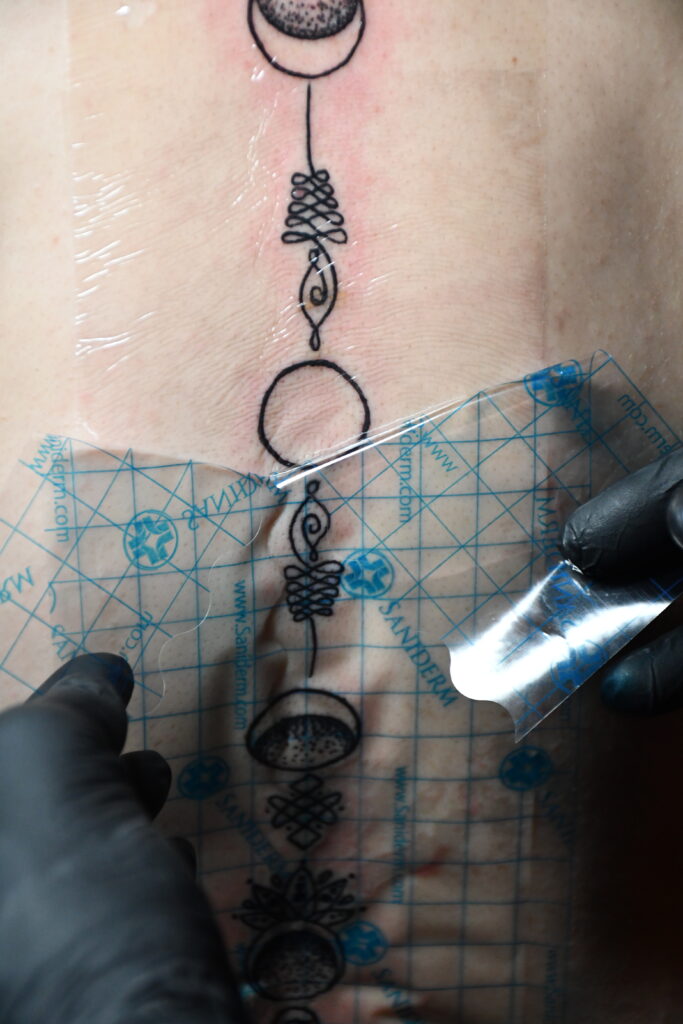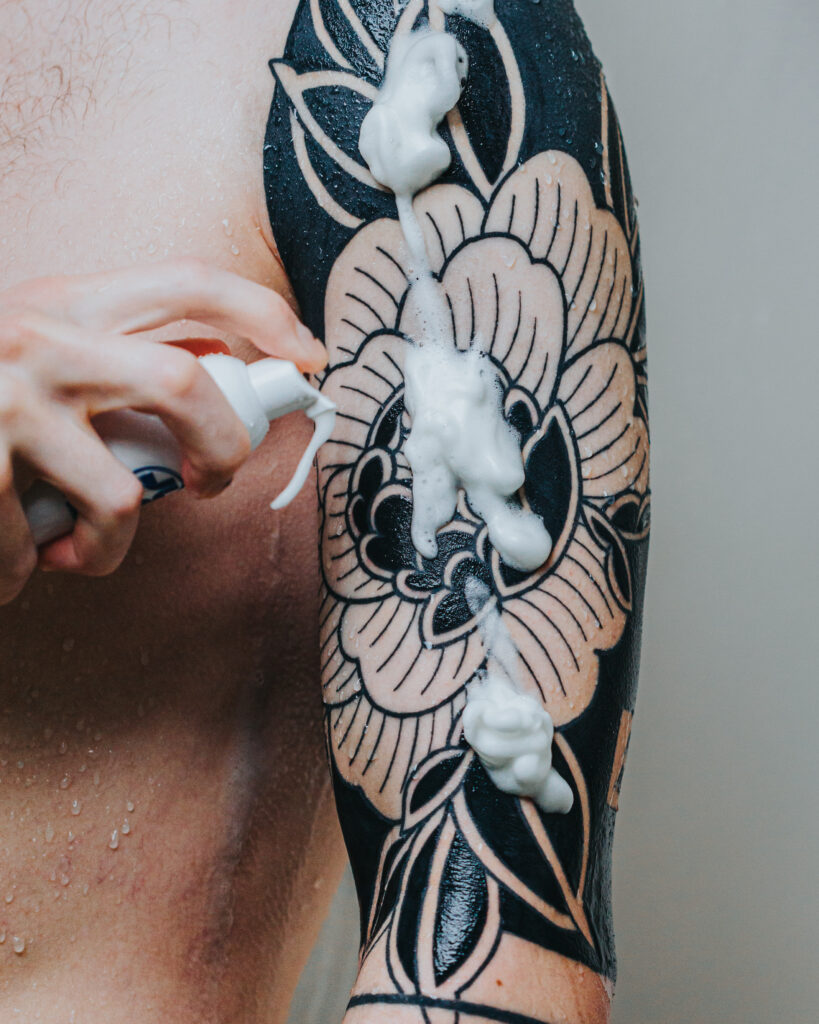Congratulations on your new tattoo! Not only do you now have a piece of artwork on your skin, but your personal style is on display. Before you head out to enjoy and perhaps show off the design and the tattoo artist’s talent, you need to follow tattoo aftercare instructions to ensure your tattoo continues to look great, heals well, and that you aren’t vulnerable to infections or scaring.
While tattooing is becoming increasingly popular, with 4 in 10 Americans now sporting ink, there is a risk of infection or the introduction of foreign contaminants into the skin from the ink-covered needles or because the skin is more vulnerable as it’s healing.
Proper Tattoo Care
To enhance the healing process, tattoo aftercare starts immediately after your tattoo session is completed. Your licensed, reputable tattoo artist will finish off the tattoo by applying a thin layer of ointment over the tattoo. The tattoo will then be covered in a protective wrap or bandage to prevent bacteria and other contaminants from getting into your healing skin. As a bonus, the protective wrap also protects against irritants like clothing or sunlight.
What should you cover the tattoo with? Different tattoo shops may have different preferences, and one of the most popular and effective wraps is Saniderm Tattoo Bandages. This aftercare bandage helps prevent infections and scaring by creating a protective barrier over the fresh tattoo. This keeps dust, bacteria, moisture, and other irritants away from the skin. It’s both waterproof and breathable, so the skin can heal safely.
After 12 to 24 hours, depending on how heavily the tattoo is seeping, if you’re using Saniderm Tattoo Bandages, it’s time to remove the wrap. (Other methods may have different recommendations, so ask your specific tattoo shop for instructions.) First, ensure your hands are washed well with water and soap (for at least 20 seconds).
Once the wrap is removed, you’ll also want to gently rinse the fresh tattoo with lukewarm water and a fragrance-free, antibacterial soap that’s safe for tattoos. Avoid using any type of cloth that can exfoliate the skin, and use minimal (if any) pressure. Slosh the soapy water onto the skin to gently rinse off any blood or fluids that may be seeping from the tattoo, which is completely normal. These fluids include blood, plasma, and extra ink. Avoid putting the newly tattooed skin directly under a stream of water.
Allow the skin to dry. Don’t rub the skin with a towel. Rather, if you aren’t letting it air dry, very gently pat the skin dry with a soft, clean cloth or a clean kitchen paper towel, which can then be discarded immediately.
Next, wait around ten minutes before properly moisturizing the tattoo. Then apply a thin layer of a quality tattoo ointment that’s free of fragrance, alcohol, and chemicals that could be harmful to your fresh tattoo. Use only a small amount, and spread it evenly. If you use too much, blot off the excess with a paper towel instead of rubbing it in. Again, make sure your hands are clean and dry.

Allow the tattoo to breathe by using only a breathable tattoo bandage film while protecting your tattoo from sweat, sunlight, bumps, or rubbing on fabric. If more blood plasma leaks from the tattoo surface, clean the art again, pat the skin dry, and apply your tattoo ointment and rewrap with clean film.
The day after the tattoo and for the next several days, wash your tattoo one to two times daily, applying the tattoo ointment each time after gently patting the skin dry and then wrap with a new, clean, breathable Saniderm tattoo bandage to protect it.
You may notice the tattoo looks a bit dull or cloudy, and scabs may form. This is a normal part of the healing process. (Please don’t pick at any scabs or peel off the dry skin as this could damage the tattoo, remove color, or lead to scarring.) And avoid wrapping the tattoo with anything that isn’t breathable as the skin needs to breathe to heal.
After a few days, the redness and any irritation will begin to fade. After a week to two weeks, the remaining scabs will start to flake away naturally. Again, please avoid picking or peeling the tattoo as this can remove some ink, damage the tattoo, or affect the color. The skin may also feel itchier, which is a sign of healing. To help relieve the discomfort, apply the appropriate tattoo ointment several times daily. Indeed, tattoo ointment will become your best friend at this point.
If, however, the tattoo still looks red or swollen or feels hot to the touch, please check in with your tattoo shop to ensure there is no infection.
In the final stages of healing, between two weeks and one month after the tattoo, you may still see some dry, dead, or dull skin, but the flakes and scabs should now be clearing up. Continue cleaning with a tattoo-approved soap, patting the skin dry (avoiding rubbing or using a rough cloth), and moisturizing with a tattoo ointment as the outer layers of skin heal completely. It can take up to four months for the lower layers of the skin to completely heal, leaving your tattoo looking as the artist drew it.
Once the tattooed skin surface feels like the rest of your skin, you’ll know it’s fully healed.
What Ointment Do You Put on a Tattoo?

With all the emphasis on using a quality tattoo ointment, the natural question is what tattoo ointment is recommended. Some tattoo artists, of course, have their own preferred tattoo ointment recommendations.
Saniderm® offers several quality, affordable options, depending on how recently you got inked. These include:
- Sanibalm is made for freshly tattooed skin and helps soothe and hydrate itchy skin to promote healing.
- Sanibalm Plus+ is designed for the few weeks after getting a tattoo. This intensely hydrating, calming balm helps protect the tattoo to prevent scars and distortion while preserving the color and appearance to help enhance its lifespan.
- Saniderm Daily Lotion is for long-term care to hydrate and protect the skin, so your tattoo continues to look flawless, and the colors look vibrant for years to come. It’s not just great for tattoo aftercare. It’s also a great daily hand and body lotion to deeply nourish the skin.
Preventing Potential Tattoo Complications
As your tattoo heals, you’ll want to take extra precautions to ensure it stays as beautiful and vibrant as possible. That starts with protecting it from the sun. However, don’t use sunblock until it’s completely healed as the chemicals in sunscreens may damage the tattoo. Instead, wear protective clothing whenever you’re outside or exposed to ultraviolet (UV) light.
When to Call Your Tattoo Artist or Doctor
It can take time for a tattoo to heal, and the skin may look irritated after you have received your tattoo, especially for those with sensitive skin or if you have a bigger tattoo.
You may experience minor bumps or rashes, which can be dealt with at home with the help of proper cleaning and tattoo aftercare, some quality antibacterial tattoo ointment, hydration, healthy food, and rest to promote skin healing.
That said, if you experience more severe signs of infection, please ensure you reach out to not only your tattoo shop but your doctor as well. Signs of infection include:
- Swelling or hard, raised tissue of the area that’s been tattooed
- Sores, especially if they’re pussy, red, or hot
- Bad odor
- Red streaking from the tattoo
- Fevers of 102 degrees F (38.9 C) or higher
- Feeling waves of hot and cold
- Abnormal shivering
- Extreme thirst
- Impetigo
Fortunately, most tattoo infections are easy to treat with the help of a doctor and a round of antibiotics. Better yet, you may be able to prevent infections from occurring in the first place with proper tattoo aftercare.
Tattoo Aftercare Dos and Don’ts
What you do after getting your tattoo can affect how it looks right after you’ve gotten your art and years into the future. Here are some of the most important dos and don’ts for proper tattoo aftercare to help your skin heal and the ink to last.
- Do touch or care for your tattoo ONLY when your hands are clean
- Do ask your tattoo artist for how long you should wait before removing the protective covering
- Do follow your tattoo artist’s instructions for the best way to care for your tattoo, including what products to use on your fresh tattoo
- Do keep tattoo ointment with you to use if your tattooed skin feels itchy or is peeling
- Do wait for it to heal and avoid heavy partying or excessive behaviors to allow your immune and lymphatic system the chance to heal the tattoo completely
- Do avoid excessive or prolonged sun exposure
- Do wear protective clothing, especially whenever outside
- Do call your tattoo shop or doctor if you see signs of an infection
- Do keep it clean by regularly showering with a quality, fragrance-free, tattoo-safe soap
- Do apply a quality tattoo ointment recommended by your tattoo artist to keep it moisturized and help it heal
- Do avoid harsh chemicals, which can damage your art
Things Not to do After Getting a Tattoo
- Don’t smoother the tattoo with too much ointment or lotion, which can clog pores and lead to a rash
- Don’t use sunscreen or sunblock on your tattoo until after it’s healed
- Don’t sunbathe, which can cause the tattoo to fade
- Don’t pick at, itch, or rub your tattoo as it heals
- Don’t cover the tattoo with tight clothing, so the skin can’t breathe
- Don’t immerse your body in water, such as swimming, hot tubbing, or long baths, until it’s healed
Long-Term Tattoo Aftercare

To ensure your tattoo continues to look as good as possible for the near and long term, here are some tips for long-term tattoo aftercare:
- Keep it clean by washing regularly with a gentle, tattoo-friendly soap. (That is, one that’s mild and free of fragrances.)
- Keep hydrated by drinking plenty of water so the skin stays moisturized from within.
- Watch for the sun and wear SPF clothing so the tattoo doesn’t fade.
- Watch what you wear, as itchy clothing may lead to damage to the tattoo (and isn’t all that comfortable anyway).
- Avoid large weight fluctuations as this can stretch out or shrink the skin, which can make the tattoo look distorted.
Tattoo Aftercare Takeaway
Sure, tattoos require a bit of TLC after you’ve been inked. But it’s worth the effort to enjoy the beautiful artwork and the memories it brings to life for decades to come.
Remember, tattooing is a medical procedure. A cluster of needles is repeatedly inserted into the skin, so it requires diligent aftercare as it heals. Otherwise, you may find you’re left with an infection, scarring, or a distorted-looking tattoo and potential health issues.
Please use this site to help you care for your fresh tattoo, and when in doubt or if unsure about how your tattoo is healing, never hesitate to reach out to your tattoo shop or artist for advice.
With proper tattoo aftercare, your tattoo will soon heal and look amazing for years to come.
